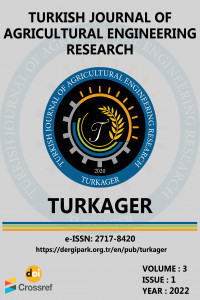Determination of Ecological Footprint of SIU-Faculty of Agriculture and Evaluation in Terms of Landscape Architecture
Determination of Ecological Footprint of SIU-Faculty of Agriculture and Evaluation in Terms of Landscape Architecture
Ecological footprint, carbon footprint, sustainability, landscape architecture Siirt University,
___
- Abdalla, Y.M.S. (2018). Çevre bilincinin ekolojik ayak izi ve kültürel dünya görüşü ile ilişkisi: Türk ve Sudanlı öğrenciler üzerine bir çalışma (Yayınlamamış yüksek lisans tezi). Kahramanmaraş Sütçü İmam Üniversitesi, Sosyal Bilimler Enstitüsü, Kamu Yönetimi Anabilim Dalı, 110 s.
- Akıllı H, Kemahlı F, Okudan K, Polat F (2008). Ekolojik ayak izinin kavramsal içeriği ve Akdeniz Üniversitesi İktisadi ve İdari Bilimler Fakültesi’nde bireysel ekolojik ayak izi hesaplaması. Akdeniz İ.İ.B.F. Dergisi (15): 1-25.
- Akkor, Ö. (2018) Sürdürülebilir Yaşama Yönelik Çevre Eğitimi Aracı Olarak Ekolojik Ayak İzinin Uygulaması Ve Değerlendirilmesi. KKTC Yakın Doğu Üniversitesi Eğitim Bilimleri Enstitüsü Çevre Eğitimi ve Yönetimi Ana Bilim Dalı, Doktora Tezi.
- Anderle, K. (2002) Integrating Life Cycle Analysis and Ecological Footprint Calculator to Foster Sustainable Behaviors. MS Thesis, University of North Texas.
- Arıca, Ş., Ç., Kağar, C. (2018). Gelecek Nesillere Yaşanabilir Bir Dünya Bırakmanın Anahtarı: Ekolojik Okur Yazarlık, Sorumlu Üretim ve Tüketim, yıl:1, Sayı: 2, ss. 31-42.
- Aşık, N., A. (2018) Ön lisans Düzeyinde Turizm Eğitimi Alan Öğrencilerin Çevreye İlişkin Tutum ve Davranışları. Sosyal ve Beşeri Bilimler Dergisi, Cilt: 10, Sayı:2, ISSN: 1309- 8012
- Atasoy,E., Ertürk, H. (2008) İlköğretim Öğrencilerinin Çevresel Tutum ve Çevre Bilgisi Üzerine Bir Alan Araştırması. Erzincan Eğitim Fakültesi Dergisi 10(1).
- Baran, M.F., Gökdoğan, O., Eren, Ö., Bayhan, Y., (2019) Determination of ecological and carbon footprints of Adıyaman Directorate of Provincial Agriculture and Forestry staffs. European Journal of Science and Technology (15): 280-288.
- Bond, S. (2003) Ecological Footprinting: Comparing Nature’s Supply with Human Demand. Ecological Footprinting.
- Coşkun, I.Ç. (2013) Investigation of ecological footprint levels of clasroom teacher candidates (Unpublished postgraduate thesis). Gazi University, Institute of Education Sciences, Departmant of Primary School Education, Ankara, 104 p. Çabuk, B., Karacaoğlu, Ö. (2003) Üniversite Öğrencilerinin Çevre Duyarlılıklarının İncelenmesi. Ankara Universitesi Eğitim Bilimleri Fakultesi Dergisi, 36. ss. 189-198
- Çetin, F. A. (2015) Ekolojik ayak izi eğitiminin 8. sınıf öğrencilerinin sürdürülebilir yaşama yönelik tutum, farkındalık ve davranış düzeyine etkisi (Yayımlanmamış Yüksek Lisans Tezi). Gazi Üniversitesi, Ankara
- Dıştan, H. (1999) Çevre Koruma Bilinci ve Duyarlılığının Oluşmasında Eğitimin Yeri Ve Önemi (Türkiye Örneği). Yayınlanmamış Yüksek Lisans Tezi. Gazi Üniversitesi, Ankara.
- Ertekin, P. (2012) Sürdürülebilir kaynak kullanımına yönelik çevre eğitimi uygulamalarının ilköğretim öğrencilerinin karbon ayak izi konusunda bilinçlenmeleri üzerine etkisi. Yayınlanmamış Yüksek Lisans Tezi, Muğla Sıtkı Koçman Üniversitesi Eğitim Bilimleri Enstitüsü, Muğla.
- Flint, K. (2001) Institutional Ecological Footprint Analysis – A Case Study of the University of Newcastle, Australia. International Journal of Sustainability in Higher Education, 2 (1), 48 – 62.
- Klein-Banai, C., Theis, L. T. (2011) An urban university's ecological footprint and the effect of climate change, Ecological Indicators, 11(3), ss. 857-860.
- Knaus, M., Löhr, D., Bernadette O. (2005) Valuation of Ecological İmpacts- A Regional Approach Using the Ecological Footprint Concept. Enviromental Impact Assesment Review, June, 12-18.
- Medina, M. A. P., Toledo-Bruno, A. G. (2016) Ecological Footprint of University Students: Does gender matter?. Global Journal of Environmental Science and Management, 2(4), 339-344.
- Meyer, V. (2004) The Ecological Footprints as an Enviromental Education Tool for Knowledge, Attitude and Behaviour Changes Towards Sustainable Living MS Thesis, University of South Africa.
- Öztürk, G. (2010) İlköğretim 7. Sınıflarda çevre eğitimi için ekolojik ayak izi kavramının kullanılması ve değerlendirilmesi. Yayınlanmamış Yüksek Lisans Tezi, Gazi Üniversitesi Eğitim Bilimleri Enstitüsü, Ankara.
- Rees, E. W. (2003) Impeding Sustainability? The Ecological Footprint of Higher Education. Planning for Higher Education, 31 (3), 88-89.
- Ryu, H. C., Brody D. S. (2006) Examining the Impacts of a Graduate Course on Sustainable Development Using Ecological Footprint Analysis. International Journal of Sustainability in Higher Education, 7 (2), 158 – 175
- Schaller, D. (1999) Our Footprints-They’re All Over the Place. Newsletter of the Utah Society for Enviromental Education, 9 (4).
- Seçme, D. (2019) Ecological footprint awareness:example of SDU faculty of architecture students (Unpublished postgraduate thesis). Suleyman Demirel University, Graduate School of Natural and Applied Scences, Department of Landscape Architecture, Isparta, Turkey, 67 p
- Wilson, J., Anielski, M., 2005. Ecological Footprints of Canadian Municipalities and Regions. Ecological Footprinting.
- WWF-Türkiye (2012). Türkiye’nin ekolojik ayak izi raporu. http://www.footprintnetwork.org/content/images/article_uploads/Turkey_Ecological_Footprint_Report_Turkish.pdf (Erişim tarihi: 07.12.2019).
- WWF, 2017. https://data.footprintnetwork.org/#/ (Erişim tarihi: 07.12.2019).
- Yayın Aralığı: Yılda 2 Sayı
- Başlangıç: 2020
- Yayıncı: Ebubekir ALTUNTAŞ
Response Surface Optimization of Convective Air Drying Process in a Hybrid PV/T Solar Dryer
Sampson UZOMA, Nnaemeka NWAKUBA, Kelechi ANYAOHA
Termal Stres Altında Yetiştirilen Küçükbaş Hayvanlarda Kısıtlı Su Uygulamasının Etkileri
Türkiye Yem Bitkileri Tarımına Karşılaştırmalı Genel Bakış ve Değerlendirme
Kırsal Alanda Sosyal Sermaye Oluşumunun Sürdürülebilir Kalkınmaya Etkisi
Merve BOZDEMİR, Zeki BAYRAMOĞLU
Effects of Tillage Systems on Energy Efficiency in Safflower Farming of Central Anatolia of Turkey
Ebubekir ALTUNTAŞ, Engin ÖZGÖZ, Mustafa GÜZEL, Bülent ÖZGENLİK
Abdullah BEYAZ, Mustafa VATANDAŞ
